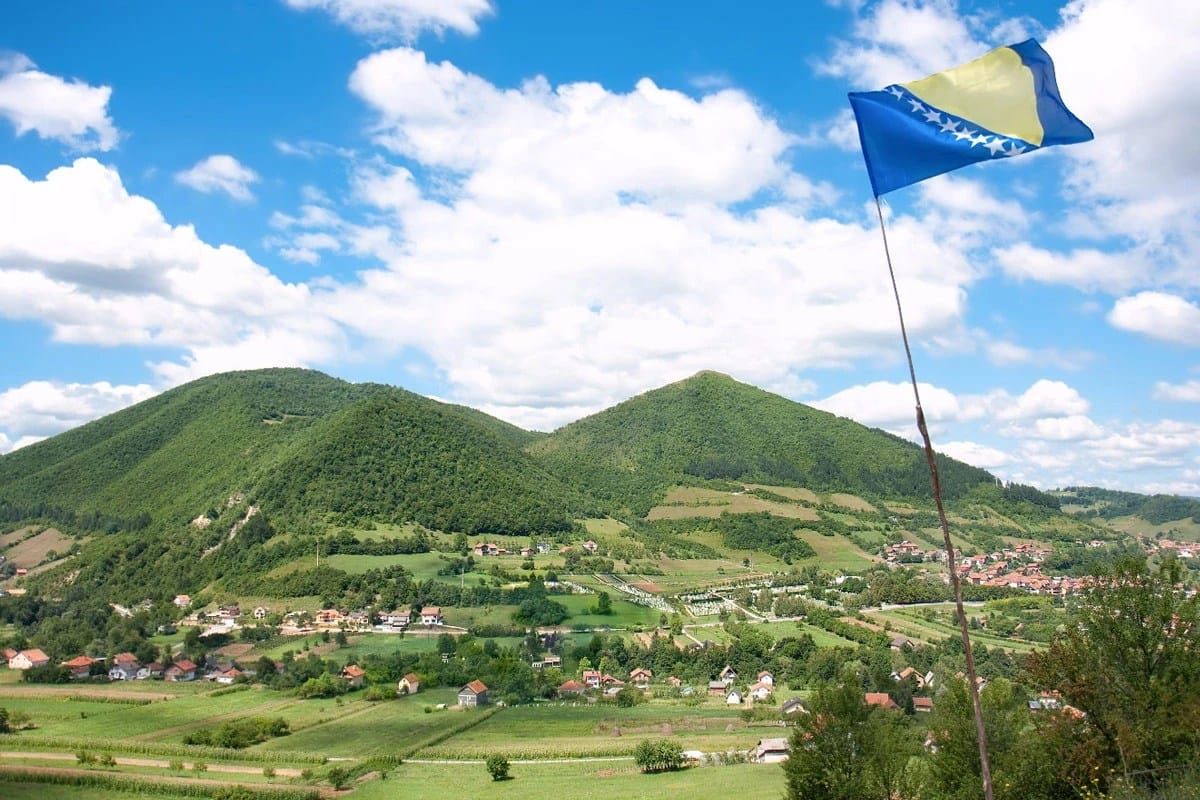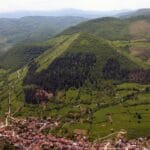Nestled in the heart of Bosnia and Herzegovina, the Visoko Valley holds a collection of hills shrouded in intrigue and controversy. Are these simply natural formations as mainstream science suggests, or could they be the remnants of ancient pyramids, whispering tales of a forgotten civilization? The debate surrounding the so-called Bosnian Pyramids challenges our understanding of history and archaeology, inviting us to explore a realm where established knowledge intersects with the allure of the unknown.
Unraveling the Enigma: Natural Wonders or Ancient Marvels?
The story of the Bosnian Pyramids began in 2005 when Bosnian-American businessman Semir Osmanagić boldly proclaimed that the hills of Visoko were not hills at all, but rather, the ruins of ancient pyramids, perhaps even older than the Egyptian pyramids. This captivating theory ignited a firestorm of debate that continues to smolder today.
Osmanagić points to the unusual symmetrical shapes of the hills, particularly the so-called Pyramid of the Sun, as strong evidence for his claim. He suggests that these formations, along with alleged concrete blocks and a network of underground tunnels, are unlikely to be the result of natural geological processes. Adding to the aura of mystery, Osmanagić claims that the pyramids possess unusual energy fields and may have been built by an advanced civilization lost to time.
However, the scientific community, particularly archaeologists and geologists, remains unconvinced. The prevailing consensus maintains that the hills are natural geological formations known as flatirons, sculpted by millennia of erosion and tectonic activity.
Exploring the Evidence: A Clash of Perspectives
The debate surrounding the Bosnian Pyramids hinges on the interpretation of evidence, with each side offering compelling arguments.
Arguments for the Pyramid Theory:
- Geometric Shapes: Proponents point to the pyramid-like shape of some hills, particularly the Pyramid of the Sun, with its seemingly precise triangular faces and edges.
- “Concrete” Blocks: Osmanagić and his team claim to have discovered large blocks within the hills that resemble ancient concrete, suggesting human construction.
- Underground Tunnels: A network of tunnels exists beneath the hills. While some may be natural formations or medieval mining shafts, others exhibit features, such as smooth walls and right-angle turns, that suggest potential artificial construction.
- Electromagnetic Anomalies: Some researchers claim to have detected unusual electromagnetic readings around the hills, suggesting the presence of energy fields or unknown technologies.
Scientific Counterarguments:
- Natural Formations: Geologists argue that the hills’ shapes can be explained by natural processes like erosion and faulting, which can create symmetrical, pyramid-like structures over vast periods.
- Geological Explanations: The “concrete” blocks have been identified as naturally occurring geological concretions, formed by the cementation of sediments over time.
- Alternative Interpretations: The underground tunnels, while intriguing, lack definitive evidence of artificial construction. Many could be natural caves or the remnants of historical mining activities in the region.
- Lack of Rigor: The scientific community has criticized Osmanagić’s research methods as lacking rigor and objectivity, calling into question the validity of some findings.
A Journey into the Unknown
The debate surrounding the Bosnian Pyramids is a testament to the enduring power of mystery and the allure of alternative theories. While the scientific consensus leans towards natural explanations, the lack of definitive proof continues to fuel speculation and attract visitors eager to explore the possibility of a lost civilization.
Whether you are drawn to the Bosnian Pyramids as potential archaeological marvels or simply as intriguing natural formations, a journey to Visoko Valley promises a unique and thought-provoking experience. It is a place where you can ponder the mysteries of the past, challenge established narratives, and perhaps even discover your own interpretation of the evidence. Who knows what secrets lie buried beneath the soil, waiting to be unearthed by time and exploration?
How to visit the Bosnian Pyramids?
Stepping off the beaten path, you’ll find yourself face-to-face with the intriguing Bosnian Pyramids. While some folks are convinced these structures were built by humans ages ago, the common scientific understanding suggests they’re naturally occurring formations. But hey, that’s part of what makes this place so fascinating, right? Even with the ongoing debate about their origins, the Bosnian Pyramids have become a hot spot for curious travelers looking for a dash of mystery.
Getting There: Your Journey Begins
Okay, so imagine this: you’re roughly 30 kilometers outside Sarajevo, the capital of Bosnia and Herzegovina. That’s where Visoko is, home to the pyramids.
- Road Trip: Hopping in a car or catching a bus are both solid options for getting there.
- Train Ride: Feel like taking the scenic route? The train is a cool way to travel to Visoko.
- Flying In: If you’re coming from farther afield, Sarajevo International Airport (SJJ) is your closest bet.
What to See: Unveiling the Mysteries
- Pyramid of the Sun: This is the big kahuna, the one that some claim is the largest pyramid on the whole planet!
- More Pyramids? More Pyramids!: Get ready to be amazed by the Pyramid of the Moon, the Pyramid of Love, and the Pyramid of the Dragon – yep, there’s a whole bunch to explore!
- Going Underground: Don’t miss the network of tunnels and chambers beneath the surface. Some say these tunnels have healing vibes, which is why lots of people come to experience them.
What to Do: Embrace Your Inner Explorer
- Guided Tours: Want the inside scoop? A guided tour will fill you in on all the history and cool facts about this place.
- DIY Adventure: Feeling adventurous? Grab a map and explore the pyramids and tunnels at your own pace!
- Healing Vibes: If those tunnels piqued your interest, you can actually book a session with a local healer and see what it’s all about.
- Time for a Break: When you’re ready to refuel, there are plenty of restaurants and cafes in the area where you can relax and enjoy some delicious food.
Tips for Your Visit: Making the Most of It
- Timing is Key: This place gets popular, so visiting during the off-season or on weekdays is a good way to avoid the crowds.
- Comfy Shoes are Your Friend: Trust me, you’ll be doing a fair bit of walking, so comfortable shoes are a must.
- Bring a Flashlight: If you’re venturing into the tunnels, a flashlight will come in handy.
- Be Respectful: This place is full of history and mystery, so treat it with respect, just like you would any other important site.
In a Nutshell: A Journey into the Unknown
So, here’s the thing about the Bosnian Pyramids: they’re a bit of an enigma. Some people are convinced they’re ancient wonders, while others believe they’re just a quirk of nature. But guess what? That’s what makes them so intriguing! They spark our curiosity and make us wonder about what might have been. Whether you’re a history buff, a nature enthusiast, or just looking for a unique adventure, the Bosnian Pyramids are a destination that will stay with you long after you’ve left.
What is the Ancient Civilization of Bosnia?
While the Bosnian Pyramids captivate the imagination, the true story of Bosnia and Herzegovina’s ancient past extends far beyond these enigmatic hills. This land, nestled in the heart of the Balkans, has witnessed the rise and fall of empires, leaving behind a tapestry woven with the threads of diverse cultures and civilizations.
Whispers of the Illyrians (8th century BC – 1st century BC)
Long before the arrival of the Romans, the Illyrians held sway over the western Balkans, including the lands that would become Bosnia and Herzegovina. Archaeological discoveries reveal traces of their settlements, fortifications, and distinctive pottery, offering glimpses into their lives and culture.
One of the most remarkable finds is the remnants of an Illyrian city in southern Bosnia, dating back to the 3rd century BC. This wasn’t a simple village, but a well-planned urban center with sophisticated architecture, showcasing the Illyrians’ advanced skills and social organization.
The Enduring Legacy of Rome (1st century BC – 4th century AD)
Like much of Europe, Bosnia eventually fell under the influence of the Roman Empire. This period brought about significant changes, as Roman culture intertwined with existing traditions. Roads, villas, and military camps were constructed, leaving a lasting imprint on the landscape. Even today, remnants of Roman roads, majestic villas, and strategic military camps dot the countryside. These tangible connections to the past offer a glimpse into a time when the Roman Empire shaped the destiny of nations.
The Tapestry of the Medieval Era (6th century AD – 15th century AD)
The fall of Rome ushered in a new era for Bosnia, characterized by the rise and fall of various kingdoms and empires. This tumultuous period saw Christianity take root and flourish, profoundly influencing the region’s culture and beliefs. Majestic churches and monasteries were constructed, standing as enduring testaments to the enduring power of faith and the architectural brilliance of the time.
Unveiling the Authentic Treasures
While the “Bosnian pyramid” claims continue to spark debate, Bosnia’s true archaeological treasures lie in its verifiable history. The intricate Illyrian city, the captivating Roman ruins, and the majestic medieval churches – these are the remnants that whisper authentic tales of the past.
Key Takeaways:
- Bosnia’s ancient history is far richer than just pyramid speculation; it encompasses the influential Illyrians, the Roman Empire’s undeniable impact, and the rise and fall of powerful medieval kingdoms.
- The “Bosnian pyramids” are generally considered natural formations, not man-made structures, according to scientific research.
- Despite the pyramid debate, Bosnia is home to authentic archaeological treasures offering a genuine glimpse into its rich pre-Roman and Roman past.
- The “Bosnian pyramid” phenomenon reminds us of the power of belief and the allure of alternative theories, even when scientific evidence suggests otherwise. It sparks curiosity and encourages us to question, explore, and engage in healthy debate.
What Country Has Pyramids and Deserts?
When we think of pyramids, our minds often journey to the sands of Egypt. But could another country, perhaps unexpectedly, hold both pyramids and deserts within its borders? The answer might surprise you: Bosnia and Herzegovina.
Nestled in the heart of the Balkans, Bosnia and Herzegovina is home to a site known as the Visoko hills. In 2005, these hills were thrust into the global spotlight when Bosnian-American businessman Semir Osmanagić boldly proclaimed that they were not hills at all, but the remnants of ancient, man-made pyramids!
Osmanagić pointed to the unusual features of these hills as evidence for his claims:
- Geometric Shapes: The hills, particularly the so-called Pyramid of the Sun, exhibit what appear to be unnaturally precise triangular faces and edges.
- “Concrete” Blocks: Osmanagić’s excavations uncovered large blocks within the hills that he claims resemble ancient concrete, suggesting human construction.
- Underground Tunnels: A network of tunnels snakes beneath the hills. While some may be natural or historical mining shafts, others possess features—smooth walls, right angles—that hint at potential artificial origins.
- Energy Fields: Osmanagić and his team claim to have detected unusual electromagnetic readings around the hills, which they believe indicate the presence of energy fields or unknown technologies.
This captivating theory ignited a firestorm of debate that continues to this day.
However, the mainstream scientific community, particularly geologists and archaeologists, remains unconvinced. They argue that the hills are natural formations known as flatirons, sculpted over eons by the erosive forces of wind and water, and shaped by the shifting of tectonic plates.
Despite the skepticism from mainstream science, the Bosnian Pyramids continue to attract thousands of visitors annually, drawn to the site’s mysterious allure and the possibility of rewriting history.
So, what is the truth behind the Bosnian Pyramids? Are they evidence of a lost civilization, or simply a product of natural forces? The debate continues, reminding us that our understanding of the past is constantly evolving and that there’s always more to discover. It’s a fascinating reminder that even in our modern age of scientific advancement, mysteries endure, sparking our curiosity and challenging us to explore the unknown.
Internal Links Used:
- Senior at What Age: Benefits & Eligibility Guide - March 29, 2025
- Unlocking Senior Benefits: How Old is a Senior? Your Complete Guide - March 29, 2025
- Master Russian Politeness:A Guide to Saying Please - March 29, 2025
















